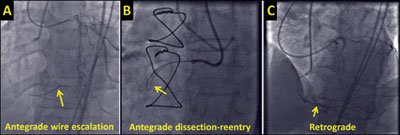The Why and How of CTO Interventions
by Emmanouil S. Brilakis, MD, PhD
Chronic total occlusion PCI is one of the “last frontiers” of interventional cardiology and has experienced significant growth in the last few years with the adaptation and refinement of advanced techniques, including retrograde and dissection/re-entry (see Figure).
As a result of this expansion, there has been a significant increase in the attempt and success rates of CTO PCI in specialized centers in the United States and abroad, inspiring many interventional cardiologists to explore this cutting-edge field.
Why Should We Learn How to Do CTO Interventions?
First and foremost, it can provide significant benefits to our patients, many of whom are currently told they have no revascularization options (ie, patients with previous CABG who present with graft failure) or may be referred for surgery because PCI is not considered to be feasible (ie, patients with isolated right coronary artery CTO and medically refractory angina). Although there are no randomized controlled clinical trials of CTO PCI vs. either medical therapy or CABG, there are increasing data that suggest successful CTO PCI can alleviate angina, improve left ventricular systolic function and possibly reduce the impact of future ACS or even improve survival. Moreover, CTO PCI can be accomplished safely with low complication rates.
 |
|
| Emmanouil S. Brilakis |
Second, it is good for interventionalists: CTO PCI requires refinement of our skills, by forcing us to look critically at the angiograms, create detailed procedural plans, apply advanced techniques of wire manipulation and equipment delivery, and pay particular attention to preventing complications, such as radiation injury or contrast-induced nephropathy. These skills are applicable to the entire spectrum of PCI and can significantly improve our efficiency and success rates.
And third, it is good for our institutions. In an era of plateauing or decreasing PCI volume, centers with successful CTO PCI programs may attract additional referrals and build reputations. Interestingly, although CTO interventions can be intensive in equipment utilization and lab time, they still appear to be financially attractive, as shown by data from Piedmont Hospital (Atlanta) presented at TCT 2011. Despite higher direct costs, the contribution margin per patient for CTO revascularization remained positive due to increased total charges and reimbursement and did not statistically vary compared with non-CTO PCI.
How Can an Interventionalist Learn to Proficiently Perform CTO Interventions?
The first step is the interventionalist must be willing to commit the time and energy required. As William Lombardi, MD, one of the fathers of CTO interventions in North America, loves to say, “You either do CTO PCI, or you don’t — there is no such thing as trying.” In other words, CTO interventions are likely to be challenging and demanding, but the key to success is persistence. With increasing experience, the procedures become faster and success rates increase.
|
Images: Emmanouil S. Brilakis, MD, PhD |
Secondly, an enthusiastic desire to learn via all possible avenues is necessary: reading the CTO literature, attending CTO courses both live or taped, talking to other interventionalists with the same interest, and eventually being taught by experienced CTO operators. All North American high-volume CTO operators are extremely keen in sharing all the “secrets of the trade” and helping anyone interested to build a CTO program
And lastly, the interventionalist needs to establish local guidelines and policies on how CTO interventions should be done. This includes establishing limits for radiation and contrast exposure; creating “CTO days” to allow for uninterrupted and concentrated focus on these procedures; and obtaining and training the cath lab staff on the use of specialized CTO-related equipment (such as stiff guidewires, specialized microcatheters and devices for subintimal crossing and re-entry) and techniques.
What to Expect From CTO Corner
The goal of this column will be to provide updates on the current status of CTO interventions, describe technical “tips and tricks,” review the relevant literature and hopefully encourage interventionalists to become immersed in this area. It is my belief that performing CTO interventions is one of the main reasons why it is so exciting to be an interventionalist in 2012.
Emmanouil S. Brilakis, MD, PhD, is the director of the cardiac catheterization laboratory at the VA North Texas Health Care System, Dallas, and is associate professor of medicine at the University of Texas Southwestern Medical Center, Dallas. He is also a Cardiology Today Intervention Editorial Board member.
Disclosure: Dr. Brilakis receives speaker honoraria from St. Jude Medical and Terumo; research support from Abbott Vascular and InfraReDx; and his spouse is an employee of Medtronic.

